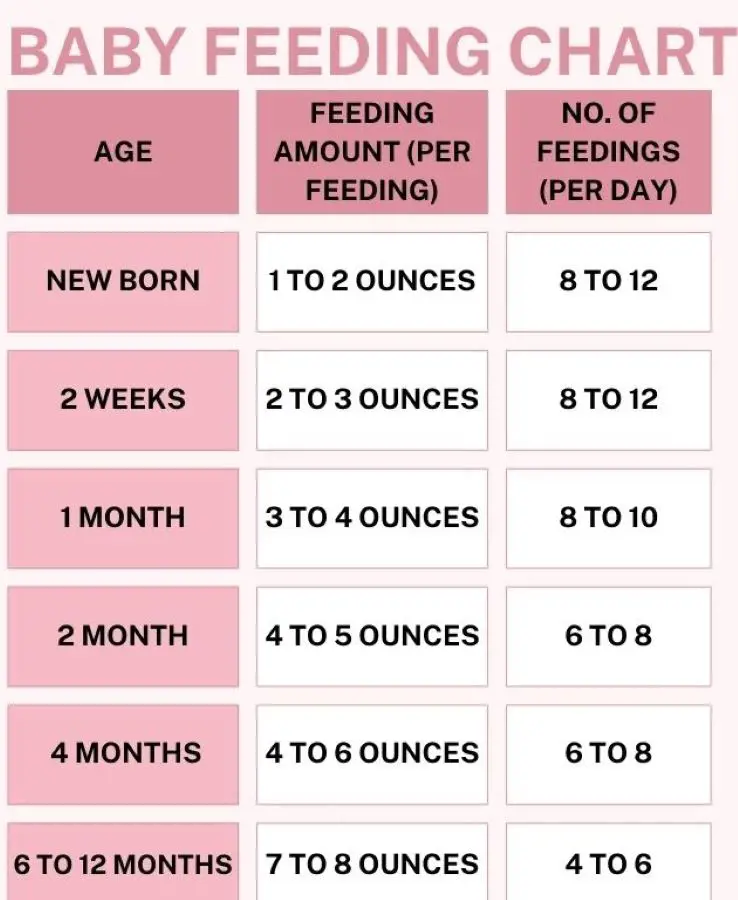Baby Feeding Chart and Schedule Guide for Every Stage

Feeding your little one is an exciting journey that can be both thrilling and daunting for new parents. Understanding your baby's unique nutritional needs at each stage of their development is key to fostering healthy growth.
In our comprehensive Baby Feeding Chart and feeding schedule, we've decoded the art of nourishment, offering insights and tips tailored to your baby's age in months. From those early days of gentle milk sips to the adventurous world of textured solids, this research-proven information provides a roadmap for every parent.
Baby Feeding Chart By Age
Here's a summary of the baby feeding chart by month from newborns to 1 year olds.

We've crafted a simple and beautiful chart just for you, capturing all the essential details of your baby's feeding schedule based on data from Parents. From the frequency of feedings to portion sizes, consider this chart your compass, guiding you effortlessly through the delightful journey of nourishing your baby.
Feeding Schedule for Newborns

In the first few days after birth, newborns should be fed on demand every 2-3 hours, not on a strict schedule, according to NHS. You may feed them either breast milk or formula milk as recommended by the professionals. Look for early hunger cues like rooting, mouthing, or sucking motions. Allow them to eat as long as they want per feeding, which may be 10-20 minutes per breast.
Expect to feed 8-12 times per day, including longer cluster feedings in the evenings. Newborns have very small stomachs so they need smaller, frequent feedings. Keep track of wet/dirty diapers to ensure they are eating enough. After feeding, let them burp for at least 10-15 minutes, using gentle patting or circular motions. Keep them upright for some time to avoid spit up or choking.
Feeding Schedule For 1 to 3 Months Old

From 1-3 months, infants start developing more of a routine but still feed on demand. Offer breastmilk or formula every 2-3 hours, aiming for 6-8 feedings per 24 hours. Allow them to feed from one or both breasts for 10-15 minutes each. Watch for hunger signals like rooting, sucking motions.
Formula-fed babies may start stretching to 3-4 hours between feedings. As spit-up, gassiness, and fussiness are common issues at this stage, try burping frequently. You can do that by holding upright after feeds, gentle tummy massage, and bicycling legs.
Avoid overfeeding or forcing them to finish bottles. Expect slower feeding as they get more efficient at extracting milk.
Feeding Schedule For 4 to 6 Months Old

From 4-6 months, babies become more alert and efficient at feeding. Breastfed babies still feed on demand, while formula-fed babies can shift to a schedule of 4-5 feedings per day. Space daytime feedings about 4 hours apart. Introduce iron-fortified cereal mixed with breast milk or formula. Then begin pureeing vegetables, fruits, and meats. You can introduce one new food at a time.
Offer solids once per day at first after a breast or bottle feeding, then slowly increase to 2-3 feedings of solids per day while reducing bottle quantities. Sit baby upright, engage them with developmental Montessori toys, and praise for positive feeding experiences.
Feeding Schedule For 6 to 9 Months Old

Feeding times get messier from 6-9 months as babies gain mobility. Offer a mix of pureed or mashed foods along with some soft finger snacks. You can vary the textures and flavors for healthy development of chewing and swallowing. Give 2-3 small meals of solids in addition to 24-32 ounces of formula daily, separated by 2-3 hours.
Or you can also nurse first before solids, then offer meals spaced every 4 hours. Introduce an open cup for sips of water with meals. Sit baby in a high chair and use baby spoons/forks. Allow them to use hands or hold spoons to baby-led weaning. Praise them for feeding attempts and minimize pressure or praise focused on finishing food or trying favorites.
Feeding Schedule For 9 to 12 Months Old

From 9–12 months, you may expand feeding schedule to 3 small meals plus 1-2 nutritious snacks per day. Portions can be increased to around 1/4 cup per food. Make sure the baby is sitting upright supported in a high chair. Encourage self-feeding with bowls, spoons, and straw cups as coordination allows. Cut soft foods into small pieces that the baby can pick up.
Offer a variety of textures and natural flavors. Continue breastfeeds before meals or as desired. Babies this age should drink about 7 to 8 ounces of formula per feeding 4 to 6 times a day. Water can be given between feedings but limit juice intake. As they near toddlerhood, establish regular meal and snack times, focusing on healthy balanced options in line with your family.
Feeding Schedule For 1 Year Old and Above

After baby turns one, the goal is to transition them to eating with the family while sticking to a schedule of 3 small meals with 2-3 scheduled snacks each day. Portion sizes can increase to around 1/2 cup per food. Focus on nutrient dense whole grains, proteins, dairy, vegetables and fruits. Allow one year olds to feed themselves pieces of soft foods with their fingers, even if messy.
Combine purees with mashed/chopped items letting them advance at their own pace. Avoid pressuring kids or using food as reward or punishment as this can lead to poor eating habits. Stick to water or milk for main drinks. Limit juice to no more than 4-6 oz per day. Keep mealtimes pleasant with conversation and toys to support healthy attitudes.







